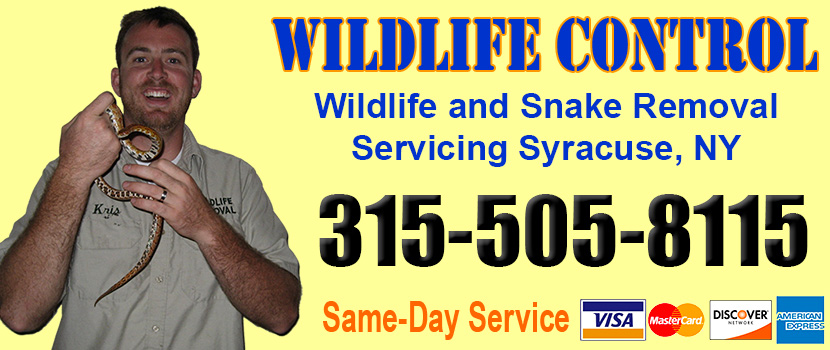
Welcome to syracusesnakes.com! I am David, a snake enthusiast living in Syracuse, NY. Many people don't know that Syracuse is in fact full of snakes! You just need to know where to find them - they can often be shy and elusive. Some New York snake species are more common outside of the city limits, in different parts of Onondaga County NY, but many types of snakes are indeed common in the more urban parts of Syracuse. This guide is meant to help educate you about the beautiful snakes of Syracuse, and to help you identify the most common snakes of Syracuse, as well as the venomous snakes of Syracuse that you should learn to recognize and avoid. If you want more detail, click here for my complete list of ALL snake species in Syracuse. Remember the following:
- Most snakes of Syracuse are harmless and don't want to encounter you
- Venomous snakes exist but are uncommon in Syracuse, New York
- Snakes eat rats and mice and are a valuable part of the New York ecosystem
- Never kill a snake - if you leave a snake alone, it will leave you alone.
Common Snake Species in Syracuse
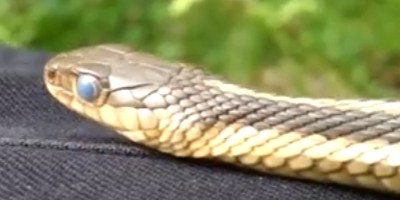 Common Garter Snake:
The common garter snake can frequently be found slithering in your lawn, fields, or near woodlands, however, there is nothing to fear as they are harmless to us humans. This type of snake, as their name suggests, are very common, and they are the most widespread snake species in North America. They can grow anywhere from 16 to 30 inches, and their color and patterns vary, but usually they have at least 3 light stripes on their body. Their main diet is insects, slugs, worms, frogs, and mice.
Common Garter Snake:
The common garter snake can frequently be found slithering in your lawn, fields, or near woodlands, however, there is nothing to fear as they are harmless to us humans. This type of snake, as their name suggests, are very common, and they are the most widespread snake species in North America. They can grow anywhere from 16 to 30 inches, and their color and patterns vary, but usually they have at least 3 light stripes on their body. Their main diet is insects, slugs, worms, frogs, and mice.
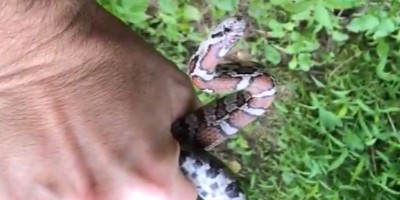 Eastern Milk Snake:
This snake species can also be found throughout the state of New York. This species is slender, with a coloring of anywhere between gray and tan, which is broken by large, dark spots that are colored dark brown or reddish-brown and outlined in black. They are carnivores and their diet mostly consists of small birds, amphibians, invertebrates, and rodents. They like to hunt during night-time but are commonly harmless. They may strike and vibrate repeatedly when threatened, but their bites rarely break the skin, making them harmless to humans.
Eastern Milk Snake:
This snake species can also be found throughout the state of New York. This species is slender, with a coloring of anywhere between gray and tan, which is broken by large, dark spots that are colored dark brown or reddish-brown and outlined in black. They are carnivores and their diet mostly consists of small birds, amphibians, invertebrates, and rodents. They like to hunt during night-time but are commonly harmless. They may strike and vibrate repeatedly when threatened, but their bites rarely break the skin, making them harmless to humans.
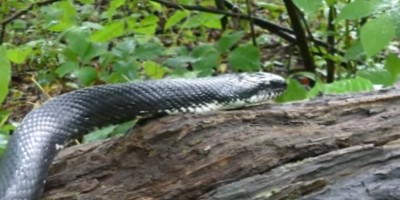 Western Black Rat Snake:
This snake is the largest snake species found in North America, and they have an average length of 3 to 6 feet, with some growing as big as 8 feet long. Western black rat snakes can be identified by their predominantly black body, with a white chin and a light-colored underbelly. Their skin between the scales may be colored red, and their upper lip, chin, and lower neck are usually colored white. Their underbelly is white or gray with dark or black spots. Young snakes might be colored gray or tan with dark brown or black spots, but they will eventually grow into a more even black coloring once they have reached adulthood. They are also carnivores and their diet mainly consists of small birds, eggs, and mammals, while rodents are their favorite food. Although they are harmless to humans, one should still exercise caution because these snakes have a very painful bite.
Western Black Rat Snake:
This snake is the largest snake species found in North America, and they have an average length of 3 to 6 feet, with some growing as big as 8 feet long. Western black rat snakes can be identified by their predominantly black body, with a white chin and a light-colored underbelly. Their skin between the scales may be colored red, and their upper lip, chin, and lower neck are usually colored white. Their underbelly is white or gray with dark or black spots. Young snakes might be colored gray or tan with dark brown or black spots, but they will eventually grow into a more even black coloring once they have reached adulthood. They are also carnivores and their diet mainly consists of small birds, eggs, and mammals, while rodents are their favorite food. Although they are harmless to humans, one should still exercise caution because these snakes have a very painful bite.
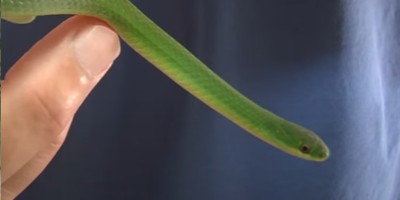 Smooth Green Snake:
This species is the only snake species in eastern North America that is entirely bright green on their upper body. This type of coloration helps them blend in with their habitat, which are moist and grassy areas, in prairies, pastures, meadows, and forests. They have a white to yellow underbelly, and their heads are slightly wider than their necks. Their average size is around 12 to 20 inches. Their diet primarily consists of insects and spiders. The males are usually smaller than females, but males have longer tails. They are very docile and harmless to humans.
Smooth Green Snake:
This species is the only snake species in eastern North America that is entirely bright green on their upper body. This type of coloration helps them blend in with their habitat, which are moist and grassy areas, in prairies, pastures, meadows, and forests. They have a white to yellow underbelly, and their heads are slightly wider than their necks. Their average size is around 12 to 20 inches. Their diet primarily consists of insects and spiders. The males are usually smaller than females, but males have longer tails. They are very docile and harmless to humans.
Venomous Snake Species in Syracuse
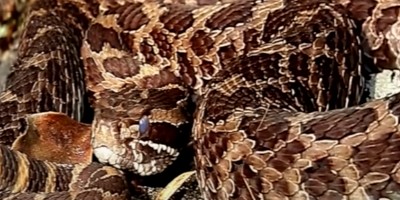 Eastern Massasauga Rattlesnake:
The eastern massasauga rattlesnake is the smallest of the three venomous snakes that can be found in Syracuse, New York. They have an average size of around 1 to 3 feet in length, and they are really rare and listed as endangered. They can be found in Oneida Lake Swamp or any large wetlands near Syracuse. These snakes have a brownish to gray coloring, with hourglass-shaped dark spots running along their back. They have a wide head and a rotund body. Although rare, one must exercise caution, because if their tail rattles, they will strike.
Eastern Massasauga Rattlesnake:
The eastern massasauga rattlesnake is the smallest of the three venomous snakes that can be found in Syracuse, New York. They have an average size of around 1 to 3 feet in length, and they are really rare and listed as endangered. They can be found in Oneida Lake Swamp or any large wetlands near Syracuse. These snakes have a brownish to gray coloring, with hourglass-shaped dark spots running along their back. They have a wide head and a rotund body. Although rare, one must exercise caution, because if their tail rattles, they will strike.
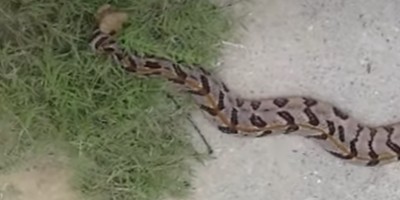 Timber Rattlesnake:
The timber rattlesnake is also threatened in New York due to loss of habitat and indiscriminate killing. One should practice extreme caution because they are extremely venomous and menacing, and they will immediately rattle and strike when faced with danger. The timber rattlesnake can either be gray with black spots, or tan/yellow-brown with dark yellow-brown patches. An adult timber rattlesnake’s average length is anywhere between 36 and 60 inches. They primarily feed on small animals like mice, rats, squirrels, and rabbits. They will bite and inject venom into the animal and wait until it’s dead before swallowing the prey.
Timber Rattlesnake:
The timber rattlesnake is also threatened in New York due to loss of habitat and indiscriminate killing. One should practice extreme caution because they are extremely venomous and menacing, and they will immediately rattle and strike when faced with danger. The timber rattlesnake can either be gray with black spots, or tan/yellow-brown with dark yellow-brown patches. An adult timber rattlesnake’s average length is anywhere between 36 and 60 inches. They primarily feed on small animals like mice, rats, squirrels, and rabbits. They will bite and inject venom into the animal and wait until it’s dead before swallowing the prey.
If you're unsure, you can email me a photo of the snake at info@syracusesnakes.com and I will email you back with the snake's species. If you found a snake skin, read my Found a Skin? page, and you can email me a photo of the skin, and I'll identify the snake for you. If you need professional Syracuse snake removal help, click my Get Help page, or see the below website sponsor I found, who provides that service.
Remember, the term is not poisonous snakes of Syracuse, it's venomous snakes of Syracuse. Poison is generally something you eat, and venom is injected into you. That said, dangerous snakes are very rare in Syracuse. The few venomous snakes of Onondaga County are rarely seen. But they are commonly misidentified, so learn about all the snake species of Syracuse in order to correctly identify them. These snakes are usually also found in the surrounding towns of Liverpool, Baldwinsville, Camillus, Manlius, Skaneateles, Cicero, Clay, DeWitt, Nedrow, Fayetteville, Marcellus, North Syracuse, East Syracuse, Solvay, Pompey, LaFayette, Tully, Minoa, Elbridge, Otisco, Van Buren, Fabius, Jordan, Mattydale, Fairmount, Westvale, Lyncourt, Galeville, Village Green, Lakeland, Seneca Knolls, and the surrounding areas.
Read our article about:
Myth and Facts: Ropes Are Effective Snake Deterrent
syracusesnakes.com domain and hosting costs made possible by the generous support of this sponsor:
